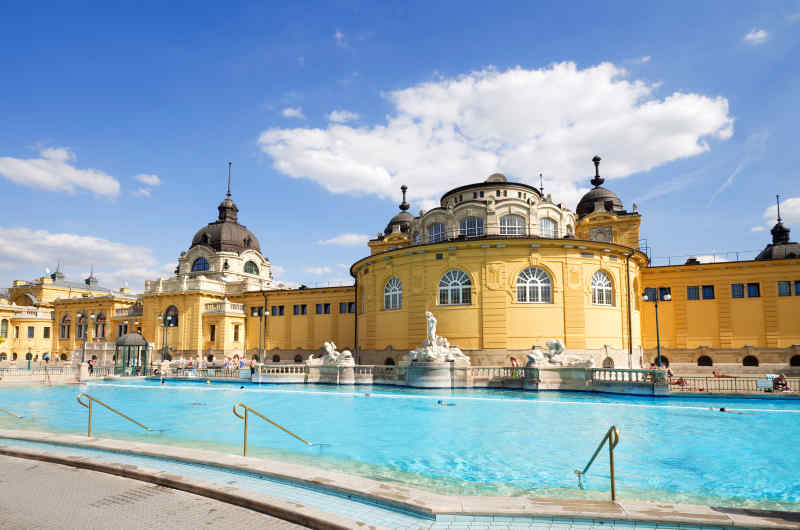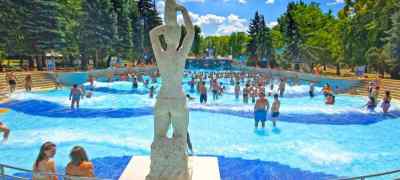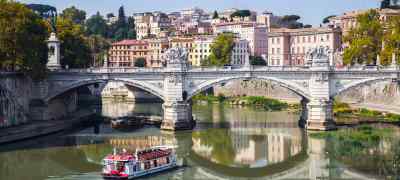By Briana Seftel
One of Europe’s most beautiful cities, Budapest is brimming in culture, history and breathtaking architecture. Discover Hungary’s capital with this helpful guide to Budapest!
View vacation packages to Budapest >
What to Know
Known as the Pearl of the Danube, Budapest is a city with an incredible history. The Celts, Romans, Mongols and Turks all left their mark on the city, which can be seen in the city’s stunning mix of architectural styles. In the mid-19th century, the Austro-Hungarian Empire officially established Budapest as Hungary’s capital, thus beginning the city’s golden age. The city faced decline in the 20th century with the two World Wars and Cold War, but has come full circle to become one of Europe's top destinations.
When you travel to Budapest, you will find the city is divided into two parts: hilly Buda and flat Pest. Buda, built on two hills, offers spectacular views of the River Danube and the city below, while flat Pest is home to shopping, lively restaurants, quirky neighborhoods and business districts.
When to Go
The best time to visit Budapest is in spring and fall, when the weather is pleasant and the city isn’t overcrowded with tourists. July and August see warm, humid weather and large crowds, while winter ushers in piping hot street snacks and a lively Christmas Market on Vorosmarty Square. The city is prone to short, sporadic showers especially in the summer, so bring an umbrella.
How to Get Around
Budapest is an extremely walkable city with stunning architecture at every turn, so be sure to pack comfortable shoes. The city also has one of the best public transportation systems in Europe with bus, tram, trolley and metro lines. By purchasing a Budapest Card, you’ll be able to travel free and without restrictions within the city limits. If you plan on taking taxis, look for the sign ”Minősített budapesti taxi/Licensed Budapest taxi” on the front left door.
Where to Eat
Whatever you’re craving, you’ll find it in Budapest. Of course, no visit to the city would be complete without trying typical Hungarian dishes like goulash flavored with paprika, referred to as Hungary’s “red gold.” Cap off a meal with pálinka, a clear fruit brandy (just make sure you look your companion in the eyes as you cheers!)
- Restaurant 21 Budapest, Fortuna u. 21 Phone: +36 1 202 2113
- Kispiac Biztro Budapest, Hold u. 13 Phone: +36 1 269 4231
- Belvárosi Disznótoros Budapest, Király u. 1d Phone: +36 1 791 4828
- Szimpla Kert Budapest, Kazinczy u. 14 Phone: +36 20 261 8669
- Kiosk Budapest, Március 15. tér 4 Phone: +36 70 311 1969
- Great Market Hall Budapest, Vámház krt. 1-3 Phone: +36 1 366 3300
- Fogasház Budapest, Akácfa u. 49-51 Phone: +36 1 783 8820
What to See
Buda Castle Quarter
A UNESCO World Heritage site since 1987, Buda Castle Quarter is the main draw to the Buda side. A palace complex that’s been home to Hungarian royalty since the 13th century, today Buda Castle is home to the Hungarian National Gallery and the Budapest History Museum. Other highlights on Castle Hill include Trinity Square, Matthias Church and Fisherman's Bastion.
Széchenyi Baths
A tradition going back to the Romans and continued by the Ottomans, Budapest’s thermal baths are an absolute must when visiting the city. The most well-known is Széchenyi Baths, built in 1913 and located in the City Park. In addition to 21 pools, Széchenyi has a gym and saunas.
Chain Bridge
The first permanent stone-bridge connecting Pest and Buda, the 19th-century Chain Bridge is the arguably the most iconic sight in Budapest. Offering beautiful views of both sides of the city, the bridge is almost always filled with tourists. If you want it all to yourself, arrive at sunrise!
Parliament
The largest building in Hungary is an unmissable sight. Stretching between Chain Bridge and Margaret Bridge on the Pest bank of the Danube, Parliament draws your attention from almost every riverside point. You can either admire the Gothic Revival-style from the outside or take a tour of the interior.
Travel tip: Tours of Parliament fill up fast, so book yours well in advance!
Margaret Island
Known as the city’s “green heart,” Margaret Island is considered by many to be one of Europe’s best city parks. The 1.6-mile park in the middle of the Danube was once a royal hunting ground, but is now home to a memorial, pedestrian paths, picnic areas, Japanese garden and small zoo.
Check out more things to do in Budapest here!
Tips and Tricks
Hungarians don’t clink their beer glasses.
The official currency in Hungary is the Hungarian Forint (HUF). You may be able to use euros in some places, but seldom at a favorable exchange rate.
Stephen's Day on August 20 is a national holiday celebrating St. Stephen, the Hungarian state founder. Join the revelers at the Pest embankment to watch the fireworks!
Tipping in Budapest isn’t obligatory, but if you choose to give, the customary rate is 10 percent of the bill.
Day Trips
Visegrád
About 25 miles north of Budapest is the former royal town of Visegrad. The city rose to prominence in the 15th century, when King Matthias built a summer residence here. Explore the Italian Renaissance-style palace and the 13th-century Solomon Tower, where you can climb to the top for beautiful views of the Danube and surrounding countryside.
Szentendre
Known for art museums, galleries and churches, the charming town of Szentendre makes a wonderful and easy day trip from Budapest. While certainly attracting a fair share of tourists, the town makes a worthwhile trip with its idyllic riverside setting and cultural institutions.
Lake Balaton
Consider spending a day on Lake Balaton, the largest freshwater lake in Central Europe. A popular place in the summer to fish, sail or just take a refreshing swim, the lake offers plenty to do even off the water. Explore Szigliget Fortress, vineyards, natural thermal spas and lake caves.














